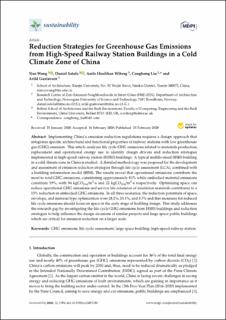| dc.contributor.author | Wang, Nan | |
| dc.contributor.author | Satola, Daniel | |
| dc.contributor.author | Houlihan Wiberg, Aoife Anne Marie | |
| dc.contributor.author | Liu, Conghong | |
| dc.contributor.author | Gustavsen, Arild | |
| dc.date.accessioned | 2022-08-10T07:10:12Z | |
| dc.date.available | 2022-08-10T07:10:12Z | |
| dc.date.created | 2020-02-25T18:08:31Z | |
| dc.date.issued | 2020 | |
| dc.identifier.issn | 2071-1050 | |
| dc.identifier.uri | https://hdl.handle.net/11250/3010960 | |
| dc.description.abstract | Implementing China’s emission reduction regulations requires a design approach that integrates specific architectural and functional properties of railway stations with low greenhouse gas (GHG) emission. This article analyzes life cycle GHG emissions related to materials production, replacement and operational energy use to identify design drivers and reduction strategies implemented in high-speed railway station (HSRS) buildings. A typical middle-sized HSRS building in a cold climate zone in China is studied. A detailed methodology was proposed for the development and assessment of emission reduction strategies through life cycle assessment (LCA), combined with a building information model (BIM). The results reveal that operational emissions contribute the most to total GHG emissions, constituting approximately 81% while embodied material emissions constitute 19%, with 94 kgCO2eq/m2·a and 22 kgCO2eq/m2·a respectively. Optimizing space can reduce operational GHG emissions and service life extension of insulation materials contributes to a 15% reduction in embodied GHG emissions. In all three scenarios, the reduction potentials of space, envelope, and material type optimization were 28.2%, 13.1%, and 3.5% and that measures for reduced life cycle emissions should focus on space in the early stage of building design. This study addresses the research gap by investigating the life cycle GHG emissions from HSRS buildings and reduction strategies to help influence the design decisions of similar projects and large space public buildings which are critical for emission reduction on a larger scale. | en_US |
| dc.language.iso | eng | en_US |
| dc.publisher | MDPI | en_US |
| dc.rights | Navngivelse 4.0 Internasjonal | * |
| dc.rights.uri | http://creativecommons.org/licenses/by/4.0/deed.no | * |
| dc.title | Reduction Strategies for Greenhouse Gas Emissions from High-Speed Railway Station Buildings in a Cold Climate Zone of China | en_US |
| dc.title.alternative | Reduction Strategies for Greenhouse Gas Emissions from High-Speed Railway Station Buildings in a Cold Climate Zone of China | en_US |
| dc.type | Journal article | en_US |
| dc.type | Peer reviewed | en_US |
| dc.description.version | publishedVersion | en_US |
| dc.source.journal | Sustainability | en_US |
| dc.identifier.doi | 10.3390/su12051704 | |
| dc.identifier.cristin | 1797491 | |
| dc.relation.project | Norges forskningsråd: 257660 | en_US |
| cristin.ispublished | true | |
| cristin.fulltext | original | |
| cristin.qualitycode | 1 | |

